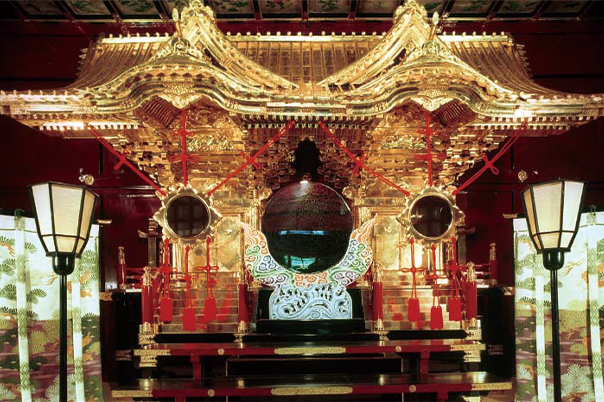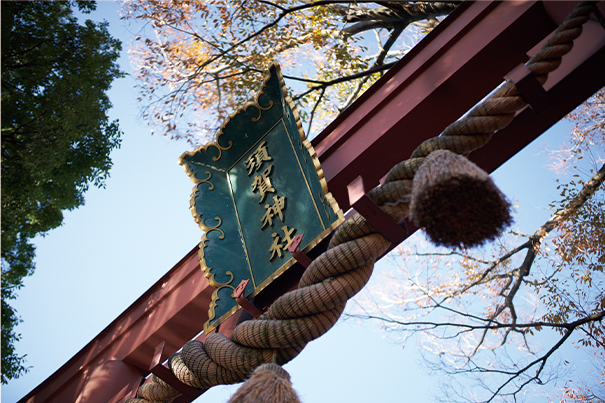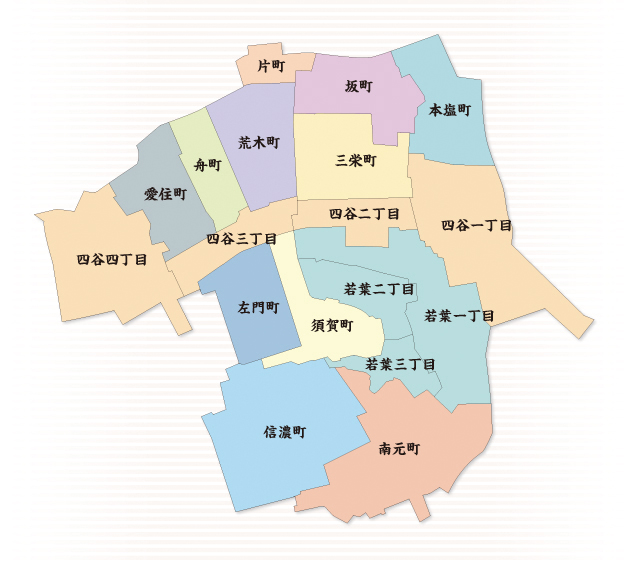須佐之男命(須賀大神)
すさのおのみこと
Susanoo-no-Mikoto

![]()

須佐之男命(須賀大神)
すさのおのみこと
Susanoo-no-Mikoto
宇迦能御魂神(稲荷大神)
うかのみたまのみこと
Uka-no-Mitama-no-Mikoto
二柱の主祭神を中心に祀り、世に天王様として親しまれ、御祭礼は四谷の「天王祭り」また「かっぱ祭り」として有名でありました。
稲荷大神は五穀豊穣・開運招福・商売繁盛の神様として、須賀大神は暦神として、また土木建築・悪霊退散・諸難・疫病除けの神として古くより庶民の信仰を集め、霊験あらたかであったと伝えられています。
主祭神の左右には櫛稲姫を始め八柱の御子を祀っています。
五男神 : 天忍穂耳命・天穂日命・天津彦根命・熊野樟日命・活津彦根命
三女神 : 多紀理姫命・市杵島姫命・多岐都姫命二柱の主祭神を中心に祀り、世に天王様として親しまれ、御祭礼は四谷の「天王祭り」また「かっぱ祭り」として有名でありました。
稲荷大神は五穀豊穣・開運招福・商売繁盛の神様として、須賀大神は暦神として、また土木建築・悪霊退散・諸難・疫病除けの神として古くより庶民の信仰を集め、霊験あらたかであったと伝えられています。
主祭神の左右には櫛稲姫を始め八柱の御子を祀っています。
五男神 : 天忍穂耳命・天穂日命・天津彦根命・熊野樟日命・活津彦根命
三女神 : 多紀理姫命・市杵島姫命・多岐都姫命
The two main deities are enshrined at the center of the shrine, and the shrine is popularly known as "Tenno-sama" (Lord Tenno) and its festivals are famous as the "Tenno Festival" and the "Kappa Festival" in Yotsuya.
Inari Ookami is worshipped as the god of good harvest, good fortune, and prosperous business, while Suga Ookami is worshipped as the god of the calendar, and as the god of civil engineering, construction, banishment of evil spirits, and protection against various calamities and epidemics.
On either side of the main deity, eight sons are enshrined, including Kushi-inahime.
Five male deities: Ama-ninshihomimi-mikoto, Ama-ninshihonomikoto, Amatsuhikone-mikoto, Kumano-johinomikoto, Katsutsuhikone-mikoto
The three main deities: Takirihime-no-Mikoto, Ichikishimahime-no-Mikoto, and Manetohime-no-Mikoto are worshipped as the two main deities.
Inari Ookami is worshipped as the god of good harvest, good fortune, and prosperous business, while Suga Ookami is worshipped as the god of the calendar, and as the god of civil engineering, construction, banishment of evil spirits, and protection against various calamities and epidemics.
On either side of the main deity, eight sons are enshrined, including Kushi-inahime.
Five male deities: Ama-ninshihomimi-mikoto, Ama-ninshihonomikoto, Amatsuhikone-mikoto, Kumano-johinomikoto, Katsutsuhikone-mikoto
Three goddesses: Takirihime-mikoto, Ichikishimahime-mikoto, and Manitohime-mikoto.
日本武命・大鳥連祖神
やまとたけるのみこと
Yamato-Takeru-no-Mikoto
例祭 : 11月(酉の市)
Regular festival : November (Tori-no-michi)
大国主命
おおくにぬしのみこと
Ookuninushi-no-Mikoto
![]()

今の須賀神社はもと稲荷神社でした。その稲荷神社は、往古より、今の赤坂、一ツ木村の鎮守で、清水谷に有ったのを、後寛永十一年に江戸城外堀普請のため、当地(現在地)を替地として拝領し、移し奉ったものと伝えられています。
須佐之男命の鎮座の儀は、寛永十四年、島原の乱に日本橋大伝馬町の大名主馬込勘由と言う人が、幕府の命に依り、兵站伝馬のご用を勤め、その功績に依り、現在の四谷の中心一円の地を拝領したのを機会に、寛永二十年、神田明神社内に祀ってありました日本橋伝馬町の守護神(須佐之男命)を地元民の総発意で四谷に合祀し、御両社として祀る様になり、俗称四谷天王社と云い、明治維新まで親しまれて来ました。明治元年に須賀神社と改称され、明治五年に郷社に昇格、戦後は制度の改正により、旧社格は撤廃されました。
社名の須賀とは、須佐之男命が出雲の国の簸の川上に八俣の大蛇を討ち平らげ拾い「吾れ此の地に来たりて心須賀、須賀し」と宣り給いて、宮居を占め給いし故事 に基づき名付けられた名称です。
往古の御社殿はつまびらかではありますが、戦災前の御社殿は、文化十一年八月に起工し、十五年の歳月をついやして文政十一年十二月に竣工したものです。大正十二年九月一日の関東大震災めでは江戸名所図会に描かれたままの姿でありました。昭和二十年五月二十四年の東京大空襲の折り、御本殿並びに御内陣と境内摂社を残した外一切の建物を失いましたが、戦後、氏子崇拝者の赤誠(せきせい)に依って 今日の復興を見ることが出来ました。
当社の本殿御内陣は文政二年に造営されたものでありますが、先の戦災の折り、辛うじて焼失を免れたものの極度に老朽化が進み、この儘では保存に支障をきたすとして、この度その大修復工事が行われ、昭和六十三年秋に着工、平成元年五月九日に落成し、同月十八日に遷座祭が執行されました。 今日の復興を見ることが出来ました。
今では都内の神社中数少ない金色燦然と輝き、荘厳華麗を極めた建築物であります。造営以来約百七十年目の大修復工事がなされました。今日の復興を見ることが出来ました。
御内陣宮殿 文政二已卯年四月四谷伝馬町二丁目住人 大工 吉見氏
The present Suga Shrine used to be Inari Shrine. It is said that the Inari Shrine was originally located in Shimizudani, the village seat of today's Akasaka and Hitotsugi villages, and that it was moved to this site (its current location) in the 11th year of Kan'ei Era, when the outer moat of Edo Castle was built as a replacement.
In the 14th year of Kan'ei Era, during the Shimabara War, a man named Magome Kanyu, a feudal lord of Nihonbashi-Odenmacho, was ordered by the Shogunate to serve as a military logistics agent, and for his services he was given an area in the center of present-day Yotsuya. The shrine was called Yotsuya Tenno-sha and was popularly known as Yotsuya Tenno-sha until the Meiji Restoration. The shrine was renamed Suga Shrine in the first year of Meiji (1868) and elevated to the status of a local shrine in 1872.
The company name "Suga" is based on a legend that Susano-no-mikoto defeated a serpent of eight summata on the river of Mino in the Land of Izumo and picked it up, declaring, "I have come to this land and my heart is Suga, Suga," and occupied a palace residence.
Although the old shrine pavilions are still visible, construction of the prewar pavilions began in August of Bunka 11, and was completed in December of Bunsei 11, after 15 years of hard work. After the Great Kanto Earthquake of September 1, 1923, it remained as depicted in the Edo Meisho Zue (Illustrations of Famous Places in Edo). During the Tokyo Air Raid of May 24, 1945, all buildings were lost except for the main shrine, inner sanctuary, and auxiliary shrines on the temple grounds.
The inner sanctuary of the main building of the shrine was constructed in 1867, but although it narrowly escaped destruction by fire during the war, it had deteriorated to such an extent that its preservation would have been compromised if it had not been restored. The restoration work was completed on May 9, 1989, and a relocation ceremony was held on May 18, 1989. The restoration work was completed on May 9, 1989, and the relocation ceremony was held on May 18 of the same month.
It is now one of the few shrines in Tokyo that shine with brilliant gold, and it is a building of the utmost solemn splendor. In the 170th year since its construction, a major restoration work was carried out. Today's restoration can be seen.
Gonaijingu Denma-cho 2-chome resident, Bunsei 2 April 4, 2011, Yoshimi Ogong
![]()
国生み神話でよく知られている伊弉諾尊(いざなきのみこと)が、妻である伊弉冉尊(いざなみのみこと)にお会いになるために、黄泉の国に行かれたのち、日向の橘の小門の阿波岐原で禊をなされた際にお生まれになった須佐之男命(すさのおのみこと)は、天照大神(あまてらすおおみかみ)、月読命(つきよみのみこと)とともに三貴子といわれる神々のうちのお一人で、日本神話の主役として重要な役割をになう神様です。強く激しいご気性ながら、純真で強い愛情をもったご性格で、農神・疫神として全国的に広く信仰されています。
須佐之男命は、荒魂神として疫病・厄除けのご神威はやく、水を支配する八岐の大蛇を退治されたり、その時お救いになった櫛稲田姫(くしいなだひめ)と結婚なされて、稲の神様である大歳神(おおとしのかみ)をお産みになるなど、水をつかさどる農耕の神様であり、人々のために植樹の大業をなされた山林の神様でもあります。
さらに、わが国で初めての和歌と伝えられる八雲立つ出雲八重垣つま籠みに 八重垣つくるその八重垣をという歌をお創りになったことから、「和歌の神様」と崇められ、学業成就の神様としてもよく知られています。
このように速素盞嗚尊は、文武・政治・土地の守護開発・航海など、人々に資源を授けたまう大地の恵みの神様、お祓いの神様として、特に地鎮祭(地祭)、方災除け、厄除け、疫病除け、家屋敷のご守護に霊験あらたかとされています。
Susano-no-mikoto was born when Izanagi no Mikoto, well known in the myth of the birth of the nation, performed misogi in the Land of Hades to meet his wife Izanami no Mikoto, and was then born at Abakibara, Tachibana no Komon in Hyuga. He is one of the three noble children, along with Amaterasu (Amaterasu-Omikami) and Tsukiyomi-no-mikoto, and plays an important role as the main character in Japanese mythology. He is widely worshipped throughout Japan as the god of agriculture and the god of pestilence, with a strong and fierce temperament but also a pure and loving nature.
He is also the god of agriculture who controls water, and he is also the god of planting trees for the benefit of people. He is also the god of forests and mountains, where he did great deeds of tree-planting for the people.
Furthermore, since he created the poem "Yaegaki Tsumagomi ni Yaegaki Tsumagomi ni Yaegaki wo Tsukuru Sono Yaegaki" which is said to be the first waka poem in Japan, he is revered as the "God of Waka" and well known as the god of academic success.
Susan Susan is believed to be the god of purification and the god of blessings of the earth, who gives people resources for civil and military affairs, politics, land protection and development, and navigation, etc. In particular, Susan is believed to be the god of the ground-breaking ceremony, protection from evil, protection from bad luck, protection from plague, and protection of house sites.
![]()
一般に土地の神様を氏神様、または産土様、あるいは鎮守様と呼びます。日本人は、初詣をはじめ、ことあるごとに氏神さまにお参りをしてきました。古い時代、氏神さまとは血縁関係にある氏族が共通におまつりする神様のことで、その氏族の祖先神であったり、氏族にかかわりの深い神さまであったりしました。
時代が下ると、その地域の土地をお守りする産土神(うぶすながみ)や鎮守(ちんじゅ)様とのはっきりした区別がなくなり、これらの神様を合わせて氏神様としておまつりすることが多くなっています。
氏神さまに対し、その神社の「氏子区域」といわれる土地内に住み、その神社を信仰し、尊厳の誠をささげている人々を氏子と呼び、同じように尊信されながらも、氏子区域外におられる人々を崇敬者と呼びます。
氏子は人生儀礼などの際に氏神様をお参りし、健やかで幸せに暮らせるよう祈願します。
古い時代の氏子とは、血縁関係にある一族のことを指していましたが、現在ではその氏神さまの地域に居住している人々や、お祭りなどの儀礼に参加する人たち全体を氏子と呼んでいます。
当神社は、須賀町・四谷一丁目・四谷二丁目・四谷三丁目・四谷四丁目・四谷三栄町・本塩町・四谷坂町・片町・愛住町・荒木町・舟町・若葉一丁目・若葉二丁目・若葉三丁目・左門町・南元町・信濃町、四谷十八ヵ町の総鎮守です。
Generally, the local deity is called Ujigami-sama, Sanchosama, or Chinju-sama.
Japanese people have visited the Ujigami shrine on every occasion, including the Hatsumode (New Year's visit to a shrine).
In ancient times, the Ujigami were deities commonly worshipped by clans related by blood, and were either the ancestral deities of the clan or deities closely related to the clan.
As time went by, there was no clear distinction between Ubusunagami and Chinju-sama, the local deity that protects the local land, and these deities were often worshipped together as Ujigami.
People who live within the “ujiko area" of a shrine and offer their faith and sincerity to the shrine are called ujiko, and those who are outside the ujiko area but have the same reverence are called reverents.
People who live within the “ujiko area" of a shrine and offer their faith and devotion to the shrine are called udeshi, and those who are outside the ujiko area but still hold the same reverence and trust are called reverents.Ujiko visit Ujigami during life ceremonies and other occasions to pray for a healthy and happy life.
In the old days, ujiko referred to family members related by blood, but today, ujiko refers to all the people who live in the area of the ujigami and who participate in festivals and other rituals.
This shrine is the general guardian of Suga-machi, Yotsuya 1-chome, Yotsuya 2-chome, Yotsuya 3-chome, Yotsuya 4-chome, Sanei-cho, Honshio-cho, Sakamachi, Katamachi, Aizumicho, Arakicho, Funamachi, Wakaba 1-chome, Wakaba 2-chome, Wakaba 3-chome, Samon-cho, Minami-Moto-cho, Shinanomachi and 18 other towns in Yotsuya.
